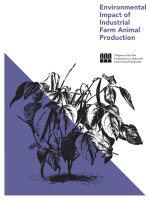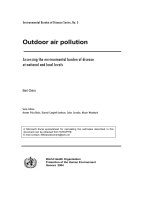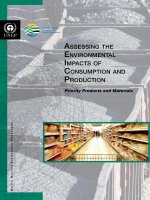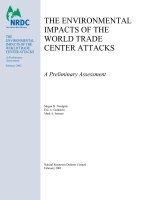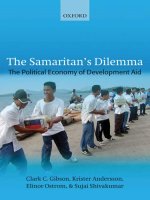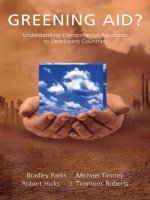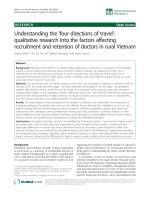- Trang chủ >>
- Khoa Học Tự Nhiên >>
- Vật lý
greening aid understanding the environmental impact of development assistance may 2008
Bạn đang xem bản rút gọn của tài liệu. Xem và tải ngay bản đầy đủ của tài liệu tại đây (1.93 MB, 363 trang )
Greening Aid?
This page intentionally left blank
Greening Aid?
Understanding the Environmental
Impact of Development Assistance
Robert L. Hicks, Bradley C. Parks,
J. Timmons Roberts, and Michael J. Tierney
1
3
Great Clarendon Street, Oxford OX2 6DP
Oxford University Press is a department of the University of Oxford.
It furthers the University’s objective of excellence in research, scholarship,
and education by publishing worldwide in
Oxford New York
Auckland Cape Town Dar es Salaam Hong Kong Karachi
Kuala Lumpur Madrid Melbourne Mexico City Nairobi
New Delhi Shanghai Taipei Toronto
With offices in
Argentina Austria Brazil Chile Czech Republic France Greece
Guatemala Hungary Italy Japan Poland Portugal Singapore
South Korea Switzerland Thailand Turkey Ukraine Vietnam
Oxford is a registered trade mark of Oxford University Press
in the UK and in certain other countries
Published in the United States
by Oxford University Press Inc., New York
© Robert L. Hicks, Bradley C. Parks, J. Timmons Roberts, and
Michael J. Tierney, 2008
The moral rights of the authors have been asserted
Database right Oxford University Press (maker)
First published 2008
All rights reserved. No part of this publication may be reproduced,
stored in a retrieval system, or transmitted, in any form or by any means,
without the prior permission in writing of Oxford University Press,
or as expressly permitted by law, or under terms agreed with the appropriate
reprographics rights organization. Enquiries concerning reproduction
outside the scope of the above should be sent to the Rights Department,
Oxford University Press, at the address above
You must not circulate this book in any other binding or cover
and you must impose the same condition on any acquirer
British Library Cataloguing in Publication Data
Data available
Library of Congress Cataloging in Publication Data
Data available
Typeset by SPI Publisher Services, Pondicherry, India
Printed in Great Britain
on acid-free paper by
Biddles Ltd., King’s Lynn, Norfolk
ISBN 978–0–19–921394–8
13579108642
Preface and Acknowledgements
From the first earth summit in Stockholm in 1972 to the 2005 G-8 meeting in
Gleneagles and the 2006 climate change negotiations in Nairobi, the issue of
how foreign aid can damage or protect the global environment has been the
source of protest, legislative debate, and reform efforts at development agen-
cies around the world. Repeated complaints by environmentalists and by sci-
entists raise pointed questions: has foreign assistance actually been ‘greened’
as many donors claim? Are aid agencies still funding ‘mega-projects’ with
severe negative environmental consequences like roads, dams and lumber
mills in rainforests? Are donors increasingly financing environmental protec-
tion and clean-up as they have promised? Is environmental foreign assistance
flowing to the places of greatest environmental need? What explains patterns
of environmental aid allocation—is it received by countries with the greatest
environmental problems? Is it being used to offset the impact of other types of
aid, or addressing geopolitical, rather than environmental concerns? Which
countries give and get environmental aid, and why?
Despite a smattering of NGO reports and numerous scholarly case studies,
we still lack a complete and coherent account of whether aid has changed in
response to new information, increased criticism, other factors, or at all. The
lack of knowledge about environmental aid has been exacerbated by three
related factors. First, previous scholars have not yet collected and analyzed
all the available data on bilateral and multilateral environmental aid. Extant
studies are based on incomplete information; therefore, their inferences may
be incorrect. Instead, different groups of scholars have often looked at either
multilateral or bilateral aid, rather than analyzing both types simultaneously.
Second, when both types of aid are analyzed within a single study, scholars
typically have relied on small samples or country studies that obscure the
broader patterns that emerge when analyzing the full population of donors
and a longer time series. Third, because donor organizations have their own
criteria for identifying and counting what is and what is not environmental
aid (and these criteria often change over time within a given organization),
it has been very difficult to make comparisons across donors or over time. In
the past, there has been no systematic way to track changes in the amount or
allocation patterns of environmentally damaging aid, which funds primarily
v
Preface and Acknowledgements
infrastructure, agro-business, energy, and extractive (e.g. mining and drilling)
industry projects that may fall into a number of sector categories. While
prior studies provide tantalizing and important hints about the allocation
and environmental impact of aid, they present an incomplete picture of
development assistance worldwide.
In this book, we rectify these shortcomings by gathering, categorizing,
and analyzing development projects from over fifty official donors (sovereign
governments, multilateral grant-making agencies, and multilateral develop-
ment banks) to more than 170 recipient countries for the twenty years where
the data are most complete and reliable (1980–99). We employ the Project-
Level Aid (PLAID) database to describe trends in aid allocation. The PLAID
database now comprises over 428,000 individual projects and we continue to
expand the database. We employ a systematic and replicable coding system
that classifies every aid project in terms of its likely impact on the natural
environment. No comparable dataset has ever been constructed, either by
academic researchers or a donor organization. We analyze this dataset using
straightforward rankings and analysis of trends, eighteen comparative case
studies of nations and sectors, and econometric models in order to better
understand where environmental aid (and traditional aid) is going and why.
Thus, this study breaks important ground by providing not only descriptive
data about long-term trends in environmental aid, but the first systematic
statistical analysis of all bilateral and multilateral environmental aid to date.
The focus of this book is primarily on issues of aid allocation. However,
we strongly believe that purpose-specific measures of aid allocation are a
vital component to understanding aid effectiveness. The PLAID database will
provide a valuable resource to those interested in evaluating the effectiveness
of specific types of aid (e.g. health, infrastructure, education, democracy-
promotion, as well as environmental). The empirical study of whether, how,
and to what extent the receipt of foreign aid influences development out-
comes is fraught with challenges. An emerging consensus among develop-
ment researchers suggests that future research should ideally evaluate the
impact that specific types of aid have on specific development outcomes.
However, because analysts lack complete and systematic categorizations of
aid flows by sector, we have witnessed a surge of econometric work on the
relationship between total aid flows and outcomes like economic growth and
poverty alleviation.
1
Such research designs cannot gauge the effect that spe-
cific types of aid have on their stated objectives.
2
Aid that targets biodiversity
1
Boone (1996); Burnside and Dollar (2000a, 2000b); Hansen and Tarp (2001); Easterly et al.
(2004a, 2004b); Collier and Dollar (2002); Easterly (2003); Roodman (2003). All these studies
assume that aid is largely fungible. Conversely, Tierney (2003) argues that the fungibility of
aid varies dramatically with the type of aid given.
2
For recent efforts to solve this problem see Fitzgerald and Sloan (2006); Bermeo (2006);
and Clemens et al. (2004).
vi
Preface and Acknowledgements
protection or sewage treatment surely affects economic growth, infant mor-
tality, and, indeed, biodiversity, differently than road construction, electricity
grids, and oil derricks do. However, scholars have thus far had no way of sub-
jecting such hypotheses to empirical tests with comprehensive and accurate
data. It is our hope that the PLAID database and the methodology employed
in this book will bring analysts a step closer to understanding the effects of
development assistance, from start to finish.
We have worked across disciplinary lines to produce a book that will
appeal to a broad audience. This collaborative research has broadened our
individual viewpoints and in this book we have approached the problem of
understanding aid without the usual disciplinary blinders. At times, we have
had predictable debates about topics such as the terminology that should
be used throughout, the level and type of empirical analysis, and the target
readership of the book. Our final goal is a compromise that seeks to translate
the academic content of this book to a broad readership. Therefore this book
is designed to be useful to environmental and development practitioners,
policy-makers, students, and researchers in economics, political science, envi-
ronmental studies, geography, and sociology. We seek to inform debate on
international environmental policy, but also believe the case of foreign assis-
tance for the environment provides an opportunity to test hypotheses derived
from work in international relations and economics, as well as illustrate the
utility of new data for cross-national research on development assistance. Far
from the last word on the matter, we are well aware of the exploratory nature
of this study and how individual cases might diverge from the overall patterns
this analysis reveals. The models and theories in this book are intended to
raise important issues, synthesize numerous academic theories, and provide
some of the first empirical evidence on a range of questions surrounding
development assistance and the environment.
The compilation and analysis of the PLAID database that forms the back-
bone of this book has put us in the debt of many people, most of all
our amazing students who were instrumental in developing this resource.
A team of fantastic students worked at William and Mary over four years,
and we are deeply grateful to all of them: Charles Adair, Ken Baldassari,
Julie Brockman, Erica Chiusano, Jeff Crowley, Keith Devereaux, Elizabeth
Dewey-Vogt, Jessie Di Gregory, Morgan Figa, Rachel Fitzgerald, Josh Geiger,
Alexander Goodspeed, Mike Goudey, Tina Ho, Ryan Hodum, Lauren Howard,
Emily Hughes, Miranda Hutten, Charlotte Jackson, Marc Johnson, Scott
Johnson, Ian Keene-Babcock, Amelia Kissick, Sarah LaVigne, James Long,
Doug McNamara, Summer Marion, Caitlin Moorman, Rosalind O’Brien, Scott
Parks, Brad Potter, Ryan Powers, John Rogers, Katie Ross-Kinzie, Laura Sauls,
Klaus Schultz, Corey Shull, David Sievers, Megan Smith, Kaity Smoot, Nino
Stamatovic, Emily Thompson, Lauren Triner, Erin Ward, Jack Warner, Joanna
Watkins, Josh Wayland, Mary Kate Weaver, Mike Weissberger, Melissa White,
vii
Preface and Acknowledgements
Brendan Williams, Heather Winn, and Dana Wojno. We would also like to
recognize both the help and enduring patience of our information technol-
ogy support, especially David Reed and Will Armstrong. Chris O’Keefe, Josh
Loud, Kaeli McCall, Rich Nielsen, and the rest of the team at Brigham Young
University provided crucial assistance in boosting the quality and quantity
of data on several multilateral funding agencies. We also owe a tremendous
debt of gratitude to Sue Peterson, Carl Strikwerda, Gene Roche, and others
in the William and Mary administration who have given us the continued
feedback, support, and assistance needed to get the PLAID project off the
ground. Sarah Caro and Jennifer Wilkinson at Oxford University Press have
been a pleasure to work with and extremely understanding of our rolling
deadlines. Dan Neilson gave us tremendously detailed comments and raised
a host of questions that improved the manuscript immensely. We owe our
greatest single debt to Jess Sloan who read the entire book more times than
any human should have to endure. Jess corrected errors, reconceived the
organization of the book, and managed the egos and the prose of four authors
from different disciplines. She is a gem.
This book benefited greatly from feedback that we received at professional
conferences and invited talks where individual chapters were presented or
where our coding procedures and data protocols were subjected to probing
questions from both scholars and practitioners. Specifically, we thank Arnab
Basu, Julia Benn, Sarah Bermeo, Tim Büthe, George Carner, Marty Finnemore,
Jeff Frieden, Valerie Gaveau, Clark Gibson, Joanne Gowa, Jean-Louis Grolleau,
Tami Gutner, Peter Haas, Barak Hoffman, Robert Keohane, David Lake, Maria
Carmen Lemos, Tammy Lewis, Eric Lief, Matt McCubbins, Phillip Mann,
Helen Milner, Dick Morgenstern, Eric Neumayer, Dan Nielson, Phil Roeder,
Steve Rothman, Justin Tingley, Erik Voeten, James Vreeland, and Kate Weaver.
Finally, we would like to thank our families for their love and support
through the endless meetings and late nights this project demanded of us.
A special thanks to Jen Tierney for the delicious barbecues that accompanied
many of these ‘working’ meetings.
Of course, all the hard work in the world would have done little without the
generous funding and support we have received over the years. Key funding
for the PLAID project has come from National Science Foundation grant #SES-
0454384, which supported much of three years of data compilation. Addi-
tional private funding from Benjamin Berinstien provided critical support for
meetings, field research, and research assistance. Student summer funding was
provided through the Andrew W. Mellon Foundation support of the Envi-
ronmental Science and Policy program at William and Mary; further funding
was granted through William and Mary’s Roy R. Charles Center. Additional
funding for student research and meetings was provided by Brigham Young
University. The book was completed while Roberts was funded in part by
a fellowship as James Martin 21st Century Professor at Oxford University’s
viii
Preface and Acknowledgements
Environmental Change Institute and a Faculty Research Assignment from the
College of William and Mary. We want to thank the Economics, Government,
Public Policy, and Sociology departments at William and Mary for space
and resources over these several years, in which the PLAID team expanded
and spread across several offices and computer labs. In Sociology, we thank
especially Dee Royster and Dianne Gilbert, and at Oxford University, we thank
Diana Liverman, Jane Applegarth, and Sue King.
Our goal is to provide a useful resource for understanding and improv-
ing the role of foreign assistance in protecting the global environment and
improving the lives of people living in both developed and developing coun-
tries. The recent report from the Intergovernmental Panel on Climate Change
suggests that the stakes for current and future generations are even higher
than when we launched this project many years ago. We hope that what
follows is both interesting, informative, and makes a small contribution to
our understanding of a very large problem facing this generation and future
generations.
Of course, we are entirely responsible for any errors that remain in this
manuscript, and the views expressed in this book are those of the authors and
do not necessarily represent those of their employers.
Williamsburg, Washington, DC, and Oxford
July 2007
ix
This page intentionally left blank
Contents
List of Figures xii
List of Tables xiv
List of Acronyms xvi
1. From Rio to Gleneagles: Has Aid Been Greened? 1
2. Billions for the Earth? Patterns of Environmental Assistance 20
3. Who Receives Environmental Aid? Patterns of Allocation and Case
Studies of Five Major Recipients 54
4. To Areas of Need, Opportunity, or Strategic Interest? Explaining
Which Countries Receive Environmental Aid and Why 91
5. Which Donors Are the Greenest? Trends in Bilateral Aid and Key
Donor Profiles 123
6. The Political Market for Environmental Aid: Why Some Donors Are
Greener Than Others 159
7. Have the Multilaterals Been Greened? Major Trends and Cases 184
8. Outsourcing the National Interest? Delegating Environmental Aid to
Multilateral Agencies 211
9. Looking to the Future of Environmental Aid 245
Appendix A: The Project-Level Aid Database 265
Appendix B: Aid Flows to Recipients 273
Appendix C: Technical Details 280
References 293
Index 328
xi
List of Figures
1.1. Nested principal–agent relationships in aid allocation bargaining process 13
2.1. Total flows of environmental aid, 1980–1999, comparing all
multilateral and bilateral donors 28
2.2. Total aid flows, bilateral and multilateral agencies combined,
1980–1999, comparing total funding for projects with likely positive
environmental impacts, likely negative impacts (‘dirty’), and those
neutral or uncertain in impacts 29
2.3. Ratio of ‘dirty’ aid to environmental aid project funding, 1980–1999,
bilateral and multilateral donors and lenders 30
2.4. Composition of bilateral environmental aid, 1980–1999: billions of
constant US$ for ‘green’ (globally significant) and ‘brown’ (local
issues) projects 32
2.5. Composition of multilateral environmental aid, 1980–1999: billions
of constant US$ for ‘green’ (globally significant) and ‘brown’ (local
issues) projects 33
2.6. Count of aid projects by type of environmental aid, 1980–1999 36
2.7. Amount of aid from all donors to environmental aid of four types,
1980–1999 37
3.1a. Top ten recipients of environmental aid, by type, 1980–1989 57
3.1b. Top ten recipients of environmental aid, by type, 1990–1999 58
3.2a. Total aid across types to China, 1980–1999 67
3.2b. Green and brown aid to China, 1980–1999 68
3.3a. Total aid across types to India, 1980–1999 72
3.3b. Green and brown aid to India, 1980–1999 73
3.4a. Total aid across types to Brazil, 1980–1999 79
3.4b. Green and brown aid to Brazil, 1980–1999 80
3.5a. Total aid across types to Kenya, 1980–1999 83
3.5b. Green and brown aid to Kenya, 1980–1999 84
3.6a. Total aid across types to Egypt, 1980–1999 86
3.6b. Green and brown aid to Egypt, 1980–1999 87
5.1. Percentage of total bilateral aid, 1980–1999 130
xii
List of Figures
5.2. Bilateral aid by type, 1980–1999 131
5.3a. Ratio of ‘dirty’ to environmental aid given by Denmark, 1980–1999 135
5.3b. Green and brown aid given by Denmark, 1980–1999 136
5.4a. Ratio of ‘dirty’ to environmental aid given by Germany, 1980–1999 138
5.4b. Green and brown aid given by Germany, 1980–1999 139
5.5a. Ratio of ‘dirty’ to environmental aid given by United Kingdom, 1980–1999 140
5.5b. Green and brown aid given by United Kingdom, 1980–1999 141
5.6a. Ratio of ‘dirty’ to environmental aid given by United States of
America, 1980–1999 149
5.6b. Green and brown aid given by United States of America, 1980–1999 150
5.7a. Ratio of ‘dirty’ to environmental aid given by Japan, 1980–1999 154
5.7b. Green and brown aid given by Japan, 1980–1999 156
7.1a. Trends in multilateral project allocation, 1980–1999 186
7.1b. ‘Dirty’/environmental aid ratio for all multilaterals, 1980–1999. Also
shows ratio of strictly defined ‘dirty’ and strictly defined
environmental projects 187
7.2a. World Bank aid: ratio of ‘dirty’ to environmental project funding (D/E
ratio), 1980–1999 196
7.2b. World Bank green and brown (global and local public goods) funding,
1980–1999 197
7.3a. Asian Development Bank aid: ratio of ‘dirty’ to environmental project
funding (D/E ratio), 1980–1999 200
7.3b. Asian Development Bank ‘green’ and ‘brown’ (global and local public
goods) funding, 1980–1999 201
7.4. Global Environmental Facility (GEF) funding by sector, 1990–1999 205
8.1. Percentage of environmental aid from bilateral donors given through
multilateral organizations, 1980–1999 217
xiii
List of Tables
2.1. 1990s environmental aid by sector: comparison of Agenda 21
prescriptions for needed aid with actual dose delivered, four sectors 52
3.1. Top ten recipients and their top five donors, 1980s (3.1a) and 1990s (3.1b) 61
4.1. Summary table of hypotheses, variables, and findings, recipient allocation 99
4.2a. Gate-keeping stage predictors of allocation of environmental and
‘dirty’ aid to recipient countries, 1990–1999 111
4.2b. Gate-keeping stage predictors of allocation of green and brown aid to
recipient countries, 1990–1999 112
4.2c. Gate-keeping stage predictors of allocation of environmental, ‘dirty’,
green, and brown aid to recipient countries from Multilateral
Development Banks (MDBs) and Multilateral Granting Agencies
(MGAs), 1990–1999 113
4.3a. Allocation amount stage predictors of allocation of environmental
and ‘dirty’ aid to recipient countries, 1990–1999 114
4.3b. Allocation amount stage predictors of allocation of brown and green
aid to recipient countries, 1990–1999 115
4.3c. Allocation amount stage predictors of allocation of environmental,
‘dirty’, green and brown aid to recipient countries, 1990–1999 116
4.4. Elasticity estimates of allocation of environmental, ‘dirty’, ‘green’ and
‘brown’ aid to recipient countries, 1990–1999; (a) Bilateral donors; (b)
All multilateral agencies; (c) Multilateral development banks; and (d)
Multilateral granting agencies. 117
5.1a. Environmental aid in real US$ 2000, major bilateral donors, 1980–1999 126
5.1b. Environmental aid per capita, major bilateral donors, 1980–1999 127
5.2. Environmental aid as percentage of total aid portfolio, bilateral
donors, 1980–1999 129
6.1. Summary table of hypotheses, bilateral donor models 175
6.2. ‘Dirty’ aid (projects likely to have negative environmental impacts) as
a share of bilateral donor portfolios 176
6.3. Environmental projects as a share of bilateral donor portfolios 178
7.1a. Environmental aid in US$ 2000, multilateral donors, 1980–1999 188
xiv
List of Tables
7.1b. The greenest multilateral donors: donors with the highest percentage
of total aid classified by PLAID as environmental, 1980s and 1990s 188
8.1. Summary table of hypotheses, multilateral donor models 228
8.2. Summary table of hypotheses: which multilateral agency will be
utilized to distribute environmental aid? 232
8.3. OLS regressions: share of environmental aid channeled through
bilateral agencies (bilateral environmental aid/total environmental aid) 236
8.4. Probit regressions of which multilateral agencies receive support and
OLS regressions of why some multilateral agencies receive more
support than others, (a) Gate-keeping stage; (b) Amount (OLS) 238
A.1. Coverage gaps in OECD data 269
A.2. Environmental coding criteria 270
B.1. Allocation of environmental aid to all recipients, as categorized by
the PLAID research project, 1980–1999; 1980–1989; 1990–1999 273
C.1. Chapter 4 summary statistics: inter-recipient models. a. Gate-keeping
stage; b. Amount stage 289
C.2. Chapter 6 summary statistics 291
C.3. Chapter 8 summary statistics 292
xv
List of Acronyms
ADBISF Asian Development Institute Special Fund
AFDB African Development Bank
AFDF African Development Fund
ASDB (ADB) Asian Development Bank
ASDF (ADF) Asian Development Fund
CDB Caribbean Development Bank
DBD ‘Dirty’ Broadly Defined (with likely negative environmental impacts)
DSD ‘Dirty’ Strictly Defined
EBD Environmental Broadly Defined
EBRD European Bank for Reconstruction and Development
EIB European Investment Bank
ESD Environmental Strictly Defined
EU European Union
G-7 Group of Seven: Canada, France, Germany, Italy, Japan, the USA,
and the UK
G-8 Group of Eight: The G-7 plus Russia
GEF Global Environment Facility
IADB (IDB) Inter-American Development Bank
IBRD International Bank for Reconstruction and Development
(World Bank)
IDA International Development Association (World Bank)
IDB FSO Inter-American Development Bank Fund for Special Operations
IIC International Investment Corporation (part of IADB)
IO International Organization
ISDB Islamic Development Bank
LDCs least developed countries
MDB Multilateral Development Bank
MGA Multilateral Grant Agency
xvi
List of Acronyms
MIGA Multilateral Investment Guarantee Agency
N Neutral aid (neither environmental nor ‘dirty’)
NDF Nordic Development Fund
NGO non-governmental organization
NIB Nordic Investment Bank
PLAID Project-Level Aid database
xvii
This page intentionally left blank
1
From Rio to Gleneagles: Has Aid
Been Greened?
A Brief History of Environmental Aid
In the summer of 1992, the Brazilian army patrolled the freshly scrubbed
streets of Rio de Janeiro to safeguard 30,000 visitors arriving from 172 coun-
tries. Kings, Premiers, Presidents, and Prime Ministers had all flown in for
one of the largest gatherings of state leaders in history: the United Nations
Conference for Environment and Development, known as the Earth Summit.
Inside the official conference site, dignitaries discussed the world’s ecological
challenges, debated the links between environment and development, and
fought pitched diplomatic battles over proposed solutions to those issues.
Outside, at Flamengo Park, thousands of NGO activists held parallel events;
building networks, issuing statements to the press, and adding to the pressure
already felt by the conference participants.
In the months preceding the Earth Summit tension between developed
and developing countries ran high. Environmentalists and voters in Western
countries pressured their elected officials to ‘do something’ about issues like
deforestation in the Amazon, ozone depletion, and global climate change.
But with some of the richest stores of biodiversity, natural resources, and
carbon located in poor countries, the potential for environmental damage
was greatest in places outside the sovereign control of Western governments.
A central dilemma facing negotiators was to determine how less developed
countries could be encouraged to act on issues that were often far below secu-
rity, development, health care, and education on their domestic agendas. An
even deeper conflict existed: fencing off forests and controlling carbon emis-
sions would almost certainly slow developing countries’ economic growth,
especially in the shorter term.
The ‘Grand Bargain’ at Rio was that wealthy countries agreed to underwrite
the participation of less developed countries in any global environmental
accord to come out of the meetings. Most developing countries, however,
1
From Rio to Gleneagles
feared this new concern for environmental protection would ‘crowd out’
foreign aid for basic human needs and economic development. Drawn up
jointly by developed and developing countries, a document called Agenda
21 was designed to break this impasse. Agenda 21 was a 700-page plan for
‘sustainable development’ that sought to bring poor countries into environ-
mental agreements while simultaneously supporting their economic devel-
opment. Chapter 33 of Agenda 21 states that ‘The implementation of the
huge sustainable development programs . . . [would] require the provision to
developing countries of substantial new and additional financial resources.’
The estimated cost of implementing Agenda 21 was $561.5 billion a year,
with the global North bankrolling $141.9 billion (or 20 per cent of the total
cost) with low or no-interest concessional lending and developing countries
footing the rest of the bill.
1
Of the assistance to developing countries, about
$15 billion a year was supposed to be devoted to global environmental issues,
with the rest targeting more localized sustainable development programs
within developing countries.
2
The Rio debate reflected the tensions that surfaced during the years of
preparatory conferences leading up to the event. A year earlier, developing
country governments issued the strongly worded Beijing Ministerial Decla-
ration on Environment and Development. The document identified poverty
as the main driver of environmental degradation and argued for ‘a special
Green Fund [to] be established to provide adequate and additional financial
assistance’ to developing countries.
3
In the Kuala Lumpur Declaration on
Environment and Development signed 29 April 1992, developing countries
argued that ‘funding should be provided in addition to, and separate from,
Official Development Assistance (ODA) target commitments by developed
countries. A specific and separate fund for the implementation of Agenda
21 should be established.’ Additionally, the Beijing Declaration called for the
Fund to ‘cover the costs of the transfer of environmentally sound technologies
1
United Nations Conference on Environment and Development (1992: section 4,
chapter 33). A few recent studies provide the data and economic analyses that explain these
figures. Water-related diseases are estimated to cost the global economy US$125 billion
per year, while alleviating such diseases would cost from US$7–50 billion per year (Gleick
1998; also see UNEP Global Environmental Outlook). With respect to global climate change,
Grubb estimates that the global South will require financial transfers of $100 billion a year
(Grubb 1990: 287). Hayes and Smith (1993: 166) put the figure at $30 billion a year. Victor
(1999) claims a funding mechanism for climate change that actually slowed the rate of
warming would be somewhere in the range of tens or hundreds of billions of dollars. See
also Luterbacher and Sprinz (2001); Schelling (2002); Barrett (2003b).
2
Robinson (1992) puts the number at over $125 billion in concessional financing, from
which the $15 billion was to address global issues.
3
Sjoberg (1999). This Fund would specifically target those problems that were not covered
by specific international agreements, such as ‘water pollution, coastal pollution affecting
mangrove forests, shortages and degradation of fresh water resources, deforestation, soil loss,
land degradation and desertification.’
2
From Rio to Gleneagles
and the costs for building up national capabilities for environmental pro-
tection and for scientific and technological research.’
4
The assistance would
range from support for national park creation to improvement of power plant
efficiency to sustainable forestry efforts in the tropics.
In Rio, developing country governments proposed that funding to the
Global Environmental Facility (GEF) be tripled and a special ‘Earth Incre-
ment’ be added to the World Bank’s development assistance funds in
order to ‘provide virtually free environmental aid to the very poorest
nations.’
5
Under all of these proposals, developing countries stressed that
‘new and additional’ funds would need to exist, so that environmental
protection funds would not be diverted from existing development aid
budgets.
Yet shortly after the agreements were signed at Rio, the ‘Grand Bargain’
between the global North and South began to unravel. The ‘Earth Increment,’
which was supposed to be a 15 per cent boost in International Development
Association (IDA) funding to the World Bank, failed to materialize.
6
The pro-
posed tripling of GEF funds proved to be a political non-starter, especially for
the United States. Because of the strong pushback from donor governments,
the Green Fund, which would support local Agenda 21 projects, also became a
casualty of the negotiating process. When developing countries—as a second-
best solution—attempted to integrate issues of local and national environ-
mental concern into the GEF’s mandate, which was originally designed to
fund global environmental protection, fierce Northern resistance quashed
their efforts.
7
Thirteen years later, in the summer of 2005, the leaders of the G-8
countries—the United States, Germany, France, Britain, Italy, Japan, Russia,
and Canada—met at the Gleneagles golf resort in Scotland. British Prime Min-
ister Tony Blair, who was ser ving as G-8 president in 2005, set two priorities for
the G-8 meeting: a substantial increase in aid, especially for Africa, in order
to ‘make poverty history,’ and more progress on addressing global climate
change. Despite the focus on poverty, environmental aid was again showcased
at Gleneagles to demonstrate Western governments’ commitment to global
environmental issues. The G-8 made promises to help poor countries more
4
Sjoberg (1999: 27). See ‘Beijing Ministerial Declaration on Environment and Develop-
ment’ (A/46/293). It was adopted by 41 developing countries in Beijing on 19 June 1991.
5
Lewis (1992: A6). This idea was publicly supported by then-World Bank President Lewis
Preston.
6
Donor governments also delivered only a fraction of the bilateral environmental funding
promised at Rio. Fairman and Ross (1996).
7
Another early indication of the West’s reluctance to commit to more environmental
aid came during negotiations on desertification, when donor governments argued for a
‘Global Mechanism’ that would mobilize and coordinate existing funds, rather than provide
additional funds (Najam 2004).
3
From Rio to Gleneagles
readily access clean energy technologies in the Gleneagles Plan of Action.
8
To
a roaring crowd outside the Gleneagles meeting, rock superstar Sting echoed
Blair, urging world leaders to address global climate change and to boost aid
for Africa. Sting vowed that the world would pay attention, and would not
accept leaders who broke promises on foreign aid. ‘Every step you take, every
vow you break, we’ll be watching you . . . ’ he sang. Once again, it seemed
environmental aid would soon be on the rise.
Yet after only three years, it appears that Gleneagles may be Rio all over
again. Besides being almost an exact repetition of promises made in 1992,
the Gleneagles declarations were very similar to those made at the first
Earth Summit held in Stockholm, Sweden, three decades before. The 1972
Stockholm Declaration included a Resolution on Institutional and Financial
Arrangements, which called for an ‘Environmental Fund’ that would assist
developing countries in their efforts towards sustainability.
9
While the same
measures have been called for repeatedly over the past thirty-five years, it is
not clear how much real progress has been made in transferring resources to
developing countries in order to mitigate, prevent, or remediate damage to
the environment.
Despite numerous and substantial promises, little research exists on how
much environmental money is new, and whether the promises of previous
environmental summits have been met. Since the mid-1980s, MDBs like the
World Bank have been harshly criticized for funding road-building, mining,
and dams which displace large numbers of people. How much do contem-
porary aid flows reflect these traditional funding patterns? If aid designed to
address environmental issues has increased, which countries are receiving the
most? Why? Which donor governments give the most? Which multilateral
donors are the ‘greenest?’ What explains these trends? In order to begin to
answer these questions and others, we need a more complete picture of aid
and the environment, as well as rigorous analysis of what might explain these
patterns. This book takes an important step toward painting that picture and
conducting that analysis.
8
It read: ‘We acknowledge the valuable role of the Global Environment Facility in facil-
itating co-operation with developing countries on cleaner, more efficient energy systems,
including renewable energy, and look forward to a successful replenishment this year, along
with the successful conclusion of all outstanding reform commitments from the third replen-
ishment.’ G-8 leaders also pledged to ‘explore opportunities within existing and new lending
portfolios to increase the volume of investments made on renewable energy and energy
efficiency technologies consistent with the MDBs’ core mission of poverty reduction ’(G-8
Gleneagles 2005).
9
Haas et al. (1992). The ‘Resolution on Institutional and Financial Arrangements’ from the
1972 Stockholm conference recommended that this Fund finance programs such as regional
and global monitoring, assessment and data-collecting systems, environmental quality man-
agement and research, and public education.
4
From Rio to Gleneagles
Why Study the Environmental Impacts of Aid Allocation?
Each year, billions of dollars flow from Western governments to private orga-
nizations and governments in developing countries for the stated purpose of
addressing environmental problems. Why do donors provide environmental
aid to developing countries? Are donors concerned with the environmental
‘rate-of-return’ they receive on their aid investment? Are they buying political
cover at home, or interested in achieving geo-strategic and commercial aims?
What are the likely implications of aid allocation patterns for the alleviation
of local, regional, and global environmental problems?
The stakes in this debate are enormous. Approximately 1.6 million people
die prematurely every year from indoor air pollution, and 1.7 million people
die prematurely every year due to unsafe water, sanitation, and hygiene.
10
Lead exposure, urban air pollution, and pesticide poisoning claim more than
a million additional lives annually. At the same time, millions of hectares of
forests are lost each year to clear-cutting, burning, and desertification, while
biodiversity is in rapid decline both on land and in the oceans. After fifteen
years of painstaking global climate negotiations, most scientists consider the
Earth’s climate to be edging perilously close to a tipping point.
11
The study of environmental aid is important not only for these substantive
reasons, but also because it provides new empirical terrain in which to test
hypotheses developed in the fields of international relations, comparative
politics, and development economics. In many respects, environmental aid
represents a ‘least likely’ case for a successful international financial transfer.
12
According to mainstream theories of international cooperation, successful
interstate financial transfers are more likely to occur when donor governments
and recipient governments are willing and able to honor their policy commit-
ments.
13
For recipients, this often entails making policy adjustments to create
an enabling environment so that foreign assistance can have its intended
effect. For donors, this means reducing funds when recipients renege on
policy reforms that are necessary for the success of the financial transfer.
14
Yet
10
UNDP (2006).
11
IPCC (2007); Roberts and Parks (2007a); Shellenhuber (2006).
12
Eckstein (1975) explains that a case is least likely when it is used to test a theory under
conditions that would be least likely to prove the theory c orrect.
13
Keohane and Nye (1993); Haggard and Moravcsik (1993); Tierney (2003).
14
There are a number of reasons why donors might be unwilling or unable to cut off
funding. If a donor country possesses intense preferences for a collective good like global
environmental protection, it may be unable to credibly threaten environmental aid with-
drawal from countries of global or regional environmental significance. For example, in
Indonesia, ‘donor governments were so pressed to find projects to appease strong “save the
rainforests” movements within their own countries that they were unable to coordinate their
efforts to bargain collectively with the Indonesian government for macro-policy changes.
Already deluged with aid projects for rainforest protection, the Indonesian government could
afford to reject loans with conditionality aimed at reforming commercial logging policies’
5
From Rio to Gleneagles
environmental aid transfers rarely occur under such circumstances. Typically,
recipients are more interested in addressing their own local environmen-
tal issues than in the regional and global problems donors want them to
address,
15
and may well lack the institutional capacity to put external funds
to good use. Consequently, donors are often put in the awkward position of
needing to fund an international public good when recipients have insuf-
ficient institutional capacity for successful implementation. In these cases,
donors might undermine the effectiveness of an environmental aid transfer if
they are unable or unwilling to provide predictable funding to well-governed
countries or withhold funding from non-credible partner countries.
16
As such,
the study of environmental aid may hold valuable lessons for students of both
development and international cooperation.
In one of the path-breaking works on this topic, Institutions for Environ-
mental Aid, Robert Keohane concludes that ‘constraints on [donor-recipient
partnerships] are strong.’
17
Recent World Bank data on project success rates
lend strong support to this conclusion. Across nine sectors, environmental
projects were the least successful projects in the World Bank’s FY01–FY03
portfolio. Only 25 per cent of Bank-financed environment projects during
this period received a ‘satisfactory’ project outcome rating, compared with
100 per cent of education projects, 86 per cent of health projects, and 87
per cent of infrastructure projects.
18
Given such challenges, why would donor
governments continue to allocate increasing amounts to environmental pro-
grams?
One possible explanation is that environmental aid can be effective under
certain conditions. Concessional finance has, after all, proven essential to
securing the participation of Southern governments in several international
(Connolly 1996: 339). Easterly offers a different explanation for the same phenomenon:
‘Most donor institutions are set up with a separate country department for each country or
group of countries. The budget of this department is determined by the amount of resources
it disburses to recipients. A department that does not disburse the loan budget will likely
receive a smaller budget the following year. Larger budgets are associated with more prestige
and more career advancement, so the people in the country departments feel the incentive
to disburse even when the loan conditions are not met’ (Easterly 2001: 116). Van de Walle
(2000: 4) also points out that donor agency ‘staff may well lack the discipline not to lend to
marginally deserving or temporarily virtuous countries if professional advancement continues
to be related to the size of one’s portfolio of projects.’
15
Connolly (1996: 330) rightly argues that ‘the provision of financial transfers for envi-
ronmental problems typically amounts to an attempt to persuade recipient countries to do
something that donor countries consider a priority rather than to provide the resources that
would enable recipients to take the environmental actions of highest priority to them’. The
central problem, according to Heltberg and Nielsen (2000: 276), is that poor nations sit on
‘another segment of their welfare function where they have higher marginal utility of wealth
and lower marginal utility of environment as compared to donors.’
16
This is of course far from an exhaustive list of all the factors that reduce the effectiveness
of environmental aid. See the chapters that follow.
17
Keohane (1996).
18
World Bank (2005c).
6
